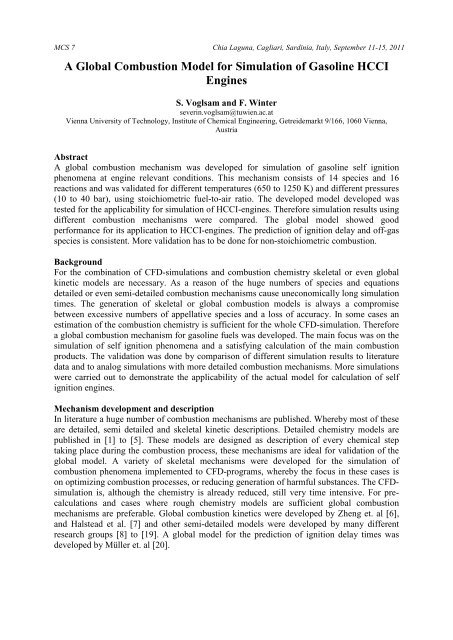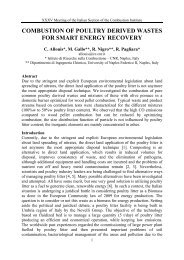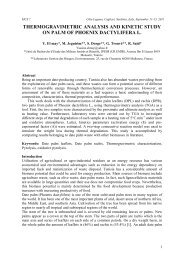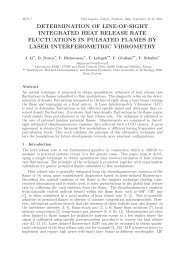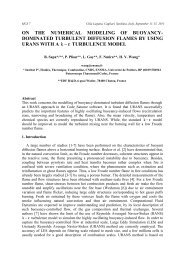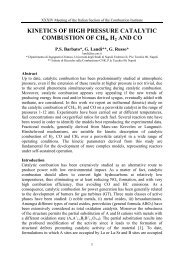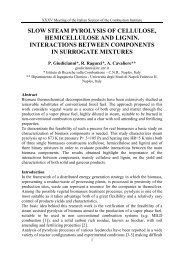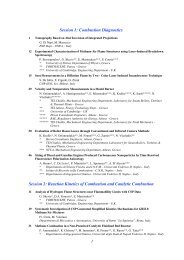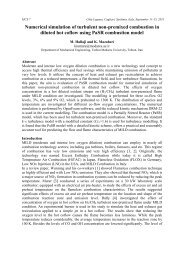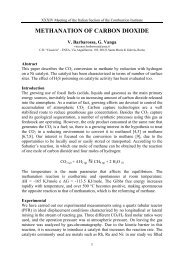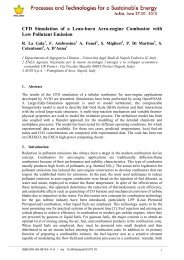A global combustion model for simulation of gasoline HCCI engines
A global combustion model for simulation of gasoline HCCI engines
A global combustion model for simulation of gasoline HCCI engines
You also want an ePaper? Increase the reach of your titles
YUMPU automatically turns print PDFs into web optimized ePapers that Google loves.
MCS 7 Chia Laguna, Cagliari, Sardinia, Italy, September 11-15, 2011A Global Combustion Model <strong>for</strong> Simulation <strong>of</strong> Gasoline <strong>HCCI</strong>EnginesS. Voglsam and F. Winterseverin.voglsam@tuwien.ac.atVienna University <strong>of</strong> Technology, Institute <strong>of</strong> Chemical Engineering, Getreidemarkt 9/166, 1060 Vienna,AustriaAbstractA <strong>global</strong> <strong>combustion</strong> mechanism was developed <strong>for</strong> <strong>simulation</strong> <strong>of</strong> <strong>gasoline</strong> self ignitionphenomena at engine relevant conditions. This mechanism consists <strong>of</strong> 14 species and 16reactions and was validated <strong>for</strong> different temperatures (650 to 1250 K) and different pressures(10 to 40 bar), using stoichiometric fuel-to-air ratio. The developed <strong>model</strong> developed wastested <strong>for</strong> the applicability <strong>for</strong> <strong>simulation</strong> <strong>of</strong> <strong>HCCI</strong>-<strong>engines</strong>. There<strong>for</strong>e <strong>simulation</strong> results usingdifferent <strong>combustion</strong> mechanisms were compared. The <strong>global</strong> <strong>model</strong> showed goodper<strong>for</strong>mance <strong>for</strong> its application to <strong>HCCI</strong>-<strong>engines</strong>. The prediction <strong>of</strong> ignition delay and <strong>of</strong>f-gasspecies is consistent. More validation has to be done <strong>for</strong> non-stoichiometric <strong>combustion</strong>.BackgroundFor the combination <strong>of</strong> CFD-<strong>simulation</strong>s and <strong>combustion</strong> chemistry skeletal or even <strong>global</strong>kinetic <strong>model</strong>s are necessary. As a reason <strong>of</strong> the huge numbers <strong>of</strong> species and equationsdetailed or even semi-detailed <strong>combustion</strong> mechanisms cause uneconomically long <strong>simulation</strong>times. The generation <strong>of</strong> skeletal or <strong>global</strong> <strong>combustion</strong> <strong>model</strong>s is always a compromisebetween excessive numbers <strong>of</strong> appellative species and a loss <strong>of</strong> accuracy. In some cases anestimation <strong>of</strong> the <strong>combustion</strong> chemistry is sufficient <strong>for</strong> the whole CFD-<strong>simulation</strong>. There<strong>for</strong>ea <strong>global</strong> <strong>combustion</strong> mechanism <strong>for</strong> <strong>gasoline</strong> fuels was developed. The main focus was on the<strong>simulation</strong> <strong>of</strong> self ignition phenomena and a satisfying calculation <strong>of</strong> the main <strong>combustion</strong>products. The validation was done by comparison <strong>of</strong> different <strong>simulation</strong> results to literaturedata and to analog <strong>simulation</strong>s with more detailed <strong>combustion</strong> mechanisms. More <strong>simulation</strong>swere carried out to demonstrate the applicability <strong>of</strong> the actual <strong>model</strong> <strong>for</strong> calculation <strong>of</strong> selfignition <strong>engines</strong>.Mechanism development and descriptionIn literature a huge number <strong>of</strong> <strong>combustion</strong> mechanisms are published. Whereby most <strong>of</strong> theseare detailed, semi detailed and skeletal kinetic descriptions. Detailed chemistry <strong>model</strong>s arepublished in [1] to [5]. These <strong>model</strong>s are designed as description <strong>of</strong> every chemical steptaking place during the <strong>combustion</strong> process, these mechanisms are ideal <strong>for</strong> validation <strong>of</strong> the<strong>global</strong> <strong>model</strong>. A variety <strong>of</strong> skeletal mechanisms were developed <strong>for</strong> the <strong>simulation</strong> <strong>of</strong><strong>combustion</strong> phenomena implemented to CFD-programs, whereby the focus in these cases ison optimizing <strong>combustion</strong> processes, or reducing generation <strong>of</strong> harmful substances. The CFD<strong>simulation</strong>is, although the chemistry is already reduced, still very time intensive. For precalculationsand cases where rough chemistry <strong>model</strong>s are sufficient <strong>global</strong> <strong>combustion</strong>mechanisms are preferable. Global <strong>combustion</strong> kinetics were developed by Zheng et. al [6],and Halstead et al. [7] and other semi-detailed <strong>model</strong>s were developed by many differentresearch groups [8] to [19]. A <strong>global</strong> <strong>model</strong> <strong>for</strong> the prediction <strong>of</strong> ignition delay times wasdeveloped by Müller et. al [20].
As basic set <strong>of</strong> reactions the mechanism developed by Zheng et. al [6] was taken into account.This <strong>model</strong> consists <strong>of</strong> eight <strong>global</strong> reactions, whereby these reactions and the accordingkinetic parameters are designed <strong>for</strong> the calculation <strong>of</strong> a fixed PRF mixture <strong>for</strong> <strong>gasoline</strong> fuels.As surrogates the common substances iso-octane and n-heptane are deployed. In case <strong>of</strong> theactual research the idea is to simulate different <strong>gasoline</strong> types by one <strong>model</strong>, there<strong>for</strong>e theZheng <strong>model</strong> has to be extended. To describe the <strong>combustion</strong> <strong>of</strong> different iso-octane and n-heptane mixtures a set <strong>of</strong> seven additional equations was added. For the <strong>simulation</strong> <strong>of</strong> theignition at different temperatures three different pathways are implemented. For the hightemperature ignition the chemical reaction is:PRF + xO 2 → yCO + z H 2 O (1)PRF represents either n-heptane or iso-octane or a mixture <strong>of</strong> both.For the low temperature ignition the following equations are responsible:PRF + 2O 2 → R1 (2)R1 → PRF + 2O 2 (3, backward <strong>of</strong> 2)R1 → 2I (4)I + PRF + xO 2 → yCO + z H 2 O (5)The species R1 represents an oxygenated intermediate radical, and I a chain propagationspecies. To describe the NTC-region two more equations are added:R1 → R2 (6)R2 → 2I (7)These equations are extending the ignition pathway between reaction 3 and reaction 5. By thisadditional step the thermal runaway is reached later and so the ignition delay time iselongated, what creates the typical maximum in the ignition delay plot (see figure 2). Thespecies R2 can be seen as shifting product <strong>of</strong> R1.To fulfill the overall <strong>combustion</strong> equation <strong>for</strong> the PRFs the CO generated in reaction 1 and 5is oxidized to CO 2 :CO + ½ O 2 → CO 2 (8)Reactions 1 to 7 have to exist two times in the <strong>combustion</strong> mechanism <strong>for</strong> the two differentPRFs with different intermediate species. As a reason <strong>of</strong> the overestimated water content andtemperature in the <strong>combustion</strong> <strong>of</strong>f-gas found during <strong>simulation</strong>s, another reaction was added.The idea is to shift water with CO to CO 2 and H 2 . In case <strong>of</strong> this <strong>global</strong> mechanism thehydrogen chemistry can be excluded, this fact reduces the number <strong>of</strong> reactions significantly,but on the other hand leads to this water overestimation.CO + H 2 O → CO 2 + H 2 (9)By adding this equation the values <strong>of</strong> temperature and water content can be corrected. Thekinetic parameters were taken out <strong>of</strong> [21] and adjusted to fit to the whole <strong>model</strong>.Reactions <strong>of</strong> the type 1 to 7 can be found two times in the mechanism description, one timeused <strong>for</strong> the iso-octane and one more time <strong>for</strong> the n-heptane. On drawback <strong>of</strong> this <strong>model</strong> isthat no direct interaction between both fuels occurs. That again generates inaccuracies at the
esults <strong>of</strong> ignition delay time <strong>simulation</strong>s. During the ignition process <strong>of</strong> iso-octane and n-heptane mixtures the starting reactions (type 1 and 2) <strong>of</strong> both PRFs are running parallel andthe thermal runaway is reached, when the ignition <strong>of</strong> the faster igniting component (nheptane)occurs. The influence <strong>of</strong> the iso-octane on the ignition process cannot be calculatedby the mechanism in this state. To solve this drawback some kind <strong>of</strong> interaction has to beimplemented, this was done by adding a species-interaction term in the kinetic description <strong>of</strong>reaction 1 and 2 <strong>of</strong> n-heptane. This interaction is comparable to the enhanced third bodyinteraction <strong>of</strong> different species. In this case it has to be a “third body deceleration”, whatmeans if iso-octane is in the fuel mixtures it is decelerating the reaction rates <strong>of</strong> the n-heptanestarting reactions (reaction 1, 2). The mathematic description <strong>of</strong> the interaction in the reactionrateequation is:⎛KR = ⎜a1 ⋅ ∑ k k02k = 2⎝[ PRF100] + a ⋅[ X ] ⎟ ⋅ k ⋅[ PRF ] x⋅[ O ] y⎞⎠(10)The reaction rate calculation is illustrated in equation 10, whereby PRF100 represents isooctaneand PRF0 represents n-heptane. The factor a is an enhancement or in the case <strong>of</strong>PRF100 a deceleration factor, consequently a negative value. Other species, in this casegenerally explained by X k , are enhanced by a factor a=1. Of course this deceleration factor isnot to be seen like the common enhanced third body interaction, it is a way <strong>of</strong> fitting a rateexpression <strong>of</strong> a <strong>global</strong> <strong>combustion</strong> <strong>model</strong>.More details about the developed <strong>global</strong> <strong>combustion</strong> mechanism will be published in [22]Validation: ignition phenomena, <strong>combustion</strong> productsThe validation <strong>of</strong> this <strong>combustion</strong> mechanism is done by comparing <strong>simulation</strong> results toliterature data [23] [24] or to <strong>simulation</strong>s using more detailed <strong>model</strong>s. During thedevelopment process the main focus was on <strong>simulation</strong> <strong>of</strong> self ignition phenomena, there<strong>for</strong>ethe ignition delay times <strong>of</strong> iso-octane, n-heptane and different mixtures <strong>of</strong> both substanceswere validated. The validation was done at pressures between 10 and 40 bar and in atemperature region <strong>of</strong> 650 to 1250K. Simulations were carried out with the program Cosilab,the ignition delay times were calculated using a 0-D <strong>model</strong> designed <strong>for</strong> investigation <strong>of</strong>ignition processes.Figure 1. definition <strong>of</strong> the ignition delay time
In figure 1 the definition <strong>of</strong> the ignition delay time can be seen whereby the program Cosilabis able to estimate the ignition point by detecting the maximal dT/dt, dp/dt or a user definedΔT. The time t1 in figure 1 represents the first stage ignition time and t2 the ignition delaytime <strong>of</strong> the full ignition process, in all diagrams t2 is displayed as ignition delay time.Figure 2. ignition delay times <strong>of</strong> n-heptane (PRF0), iso-octane (PRF100) and a mixture <strong>of</strong>80% iso-octane and 20% n-heptane (PRF80) at 40 barIn figure 2 a comparison <strong>of</strong> ignition delay times at 40 bar is shown. The experimental values[23] and [24] are compared to <strong>simulation</strong> results <strong>of</strong> ignition delay times at differenttemperatures. More validation <strong>for</strong> this <strong>model</strong> was done at lower pressures and <strong>for</strong> other PRFmixtures at stoichiometric fuel to air ratio. Overall the validation <strong>of</strong> ignition delay timesshows good agreement at different conditions. More validation was done <strong>for</strong> the <strong>of</strong>f-gasconcentrations <strong>of</strong> the main <strong>combustion</strong> products like CO 2 and H 2 O, as well as <strong>for</strong> theoccurring <strong>combustion</strong> temperature. This validation was done comparing results <strong>of</strong> the actual<strong>model</strong> to <strong>simulation</strong>s done with other more detailed <strong>combustion</strong> mechanisms.The results shown in figure 3 verify the per<strong>for</strong>mance <strong>of</strong> the <strong>combustion</strong> <strong>model</strong>, whereby theaccordance <strong>of</strong> the CO2 mole fractions is excellent, the water mole fractions, as well as thetemperature shows some differences. Overall the <strong>of</strong>f-gas composition <strong>of</strong> the <strong>simulation</strong> resultsis acceptable <strong>for</strong> general <strong>combustion</strong> applications without focus on harmful substances.
Figure 3. comparison <strong>of</strong> maximum mole fractions <strong>of</strong> CO2 and H2Oand the maximum<strong>combustion</strong> temperature <strong>of</strong> stoichiometric n-heptane with <strong>simulation</strong>s <strong>of</strong> the mechanism [4]Simulation: self ignition engineFor more validation different test cases were simulated and compared with a more detailed<strong>simulation</strong>. A common application <strong>for</strong> reduced or skeletal <strong>combustion</strong> mechanism is the<strong>simulation</strong> <strong>of</strong> <strong>HCCI</strong>-<strong>engines</strong>; there<strong>for</strong>e calculations at different conditions were carried outusing the actual kinetic <strong>model</strong> and other detailed or reduced mechanisms. The <strong>HCCI</strong>-engine<strong>simulation</strong>s were carried out using a 0-D <strong>HCCI</strong>-engine <strong>model</strong> implemented in the programCOSILAB. In table 1 a summary <strong>of</strong> the <strong>simulation</strong> conditions is shown:Engine PropertiesCompression ratio 16.5 -connection-rod length tocrank radius ratio3.71429 -cylinder volume 0.0001033 m³equivalence ratio 1 -inlet temperature 447 Kengine speed 1000 rpmTable 1. Parameters <strong>of</strong> <strong>HCCI</strong>-engine <strong>simulation</strong>
Figure 4. temperature plot <strong>of</strong> <strong>HCCI</strong>-engine <strong>simulation</strong> <strong>for</strong> n-heptane using different <strong>model</strong>s[1] (detailed), [4] (semi detailed), [8] (skeletal) and [22] (<strong>global</strong>)In figure 4 <strong>simulation</strong> results <strong>of</strong> a <strong>HCCI</strong>-engine are shown. The plot shows, that thetemperature calculated using the <strong>global</strong> mechanism is little overestimated (compared to [1],[4]). The ignition delay time is underestimated compared to [1] and [4] on the other hand itshows an overestimation compared to [8]. Differently compared to [4] the skeletal <strong>model</strong> iscapable to predict first stage ignition affects. Best estimation shows the <strong>global</strong> <strong>model</strong> to askeletal mechanism designed by Ra and Reitz [8]. This <strong>model</strong> was developed <strong>for</strong> <strong>simulation</strong><strong>of</strong> <strong>HCCI</strong> <strong>combustion</strong> <strong>engines</strong>.Figure 5. temperature plot <strong>of</strong> <strong>HCCI</strong>-engine <strong>simulation</strong> <strong>for</strong> iso-octan using different <strong>model</strong>s[1] (detailed), [8] (skeletal) and [22] (<strong>global</strong>)The comparison <strong>of</strong> the engine <strong>simulation</strong>s <strong>for</strong> iso-octane shows good con<strong>for</strong>mance in thetemperature prediction (figure 5). The ignition point simulated by the <strong>global</strong> <strong>combustion</strong>mechanism is too fast, compared to [1], but is absolutely equal to the <strong>simulation</strong> using [8],whereby this mechanism is again the one designed <strong>for</strong> <strong>HCCI</strong>-engine <strong>simulation</strong>. More
interesting than the ignition behavior <strong>of</strong> the pure PRF-substances, is the per<strong>for</strong>mance <strong>of</strong>different mixtures. As described in chapter “mechanism development and description” theinteraction between iso-octane and n-heptane is created by deceleration reaction-rates <strong>of</strong> theignition reactions. In case <strong>of</strong> the more detailed <strong>model</strong>s [1] and [8] the interaction isimplemented in the mechanism by a huge number <strong>of</strong> reactions between the intermediatespecies generated during the ignition process. At the skeletal <strong>model</strong> <strong>for</strong> the <strong>HCCI</strong>-engine<strong>simulation</strong> this interaction is implemented by a special designed interaction reaction [8]:C8H18 + C7H15 ↔ C7H16 + C8H17 (11)The comparison in figure 6 shows the results <strong>of</strong> engine <strong>simulation</strong>s using the actual <strong>model</strong>[22], [1] and [8]. The ignition delay time <strong>of</strong> the <strong>global</strong> <strong>model</strong> is in-between the other usedmechanisms, again the estimation <strong>of</strong> the pressure-plots are good. The peak pressure <strong>of</strong> thesimulated <strong>HCCI</strong> engine is at about 130 bar, this value goes with experimental data carried outby [17]. The initial values <strong>of</strong> this experiment are similar to the actual <strong>simulation</strong>s whereby aninlet pressure <strong>of</strong> 1 bar and a compression ratio <strong>of</strong> 16 were used. Just the inlet temperature <strong>of</strong>318K was lower than in this work.Figure 6. comparison <strong>of</strong> <strong>HCCI</strong>-engine <strong>simulation</strong> results using [1] (detailed), [8] (skeletal)and [22] (<strong>global</strong>)In figure 7 the change in the ignition points <strong>of</strong> different n-heptane and iso-octane mixtures isshown. Adding more and more iso-octane to the n-heptane slightly moves the ignition pointfrom about minus 25 to minus 15 degrees crank angle. This shows the way <strong>of</strong> interactiondesigned <strong>for</strong> this <strong>model</strong> is working; however there are some uncertainties in the <strong>simulation</strong> <strong>of</strong>the ignition point compared to the other mechanisms [1], [4] and [8].
Figure 7. change <strong>of</strong> <strong>HCCI</strong>-engine ignition point, by using different fuel mixtures, PRF25:25% iso-octane, 75%n-heptane, PRF50: 50% iso-octane, 50%n-heptane, PRF75: 75% isooctane,25%n-heptane,In case <strong>of</strong> this <strong>model</strong> there are just six intermediate species describing the whole ignitionprocess, compared to about 30 <strong>for</strong> [8] and a few hundred <strong>for</strong> [1]. The intermediates occurringduring the n-heptane ignition are shown in figure 8.Figure 8. Intermediate species occurring during the ignition process <strong>of</strong> n-heptane.The ignition process starts with reaction 2, reaction 1 is designed to start at highertemperatures, so in this <strong>simulation</strong> at the beginning it is <strong>of</strong> minor importance. R1 is producedby reaction 2 and is consumed by reaction 3 (reverse reaction <strong>of</strong> 2) and by the reactions 4 and6. Reaction 4 again is producing the species I (chain propagation species, scission species <strong>of</strong>R1 and R2). The species I again generates CO and CO 2 in the following reaction 5. Theoxidation to CO 2 is generating heat and the following thermal runaway. The rates <strong>of</strong> theconcurring reactions 2 and 3 are responsible <strong>for</strong> the prediction <strong>of</strong> the first stage ignition.When the temperature is rising the rate <strong>of</strong> reaction 3 is getting much faster than the rate <strong>of</strong>
eaction 2 and the first stage phase passes on to the full ignition stage. Most <strong>of</strong> R1 isconsumed by reaction 4 and smaller amounts by reaction 6; the so generated R2 is againdecomposing into I and is delivering heat to the reaction system. This intermediate step isoccurring at temperatures between 800 and 1000°C and is responsible <strong>for</strong> the NTC behavior<strong>of</strong> the mechanism.An important requirement <strong>of</strong> the <strong>global</strong> <strong>model</strong> was the <strong>simulation</strong> <strong>of</strong> the exhaust gascomposition, whereby the focus was on the species H 2 O, CO 2 , CO and H 2 . The <strong>simulation</strong> <strong>of</strong>other harmful species or even soot was not taken into account. Figure 9 shows the <strong>simulation</strong>results <strong>of</strong> the actual <strong>model</strong> and [8], again the estimation <strong>of</strong> the calculated mole fractions isgoodFigure 9. progress <strong>of</strong> the <strong>of</strong>f-gas species H2O and CO2, simulated by [8] (skeletal) and theactual <strong>model</strong> [22] (<strong>global</strong>) <strong>for</strong> n-heptane <strong>combustion</strong>As shown above the overall per<strong>for</strong>mance <strong>of</strong> the <strong>global</strong> <strong>model</strong> is good, the uncertainties in theignition delay points compared to other mechanisms are acceptable, because <strong>of</strong> the <strong>global</strong>description a certain loss <strong>of</strong> accuracy is unavoidable. On the other hand the low number <strong>of</strong>species and equations reduces the <strong>simulation</strong> time significantly.ConclusionsThe developed <strong>global</strong> <strong>combustion</strong> <strong>model</strong> consists <strong>of</strong> 14 species and 16 reactions and isvalidated <strong>for</strong> self-ignition phenomena at engine relevant conditions. The validation was donein a temperature region from 650 to 1250 K and <strong>for</strong> pressures between 10 and 40 bar. Thecomparison <strong>of</strong> experimental and simulated ignition delay times showed good agreement <strong>for</strong>iso-octane, n-heptane and mixtures <strong>of</strong> both. All the <strong>simulation</strong>s had been done <strong>for</strong>stoichiometric fuel-to-air ratios; more validation has to be done <strong>for</strong> non-stoichiometricmixtures.The <strong>simulation</strong>s <strong>of</strong> <strong>HCCI</strong>-<strong>engines</strong> show good per<strong>for</strong>mance. The ignition points and speciescharacteristics are in good accordance to other <strong>simulation</strong> results using more detailed <strong>model</strong>s.However some uncertainties occurred. As it is described earlier the ignition <strong>model</strong> <strong>for</strong> thismechanism is simple. Other mechanisms describe the ignition by using a much higher number<strong>of</strong> intermediates. These <strong>model</strong>s are able to simulate <strong>combustion</strong> phenomena much moredetailed and the chemistry reproduced is close to the processes running in nature. However,
the aim <strong>of</strong> this work was to generate a highly reduced <strong>model</strong>, capable to reflect the majorcharacteristics.AcknowledgementsThis work was supported by the EUROPEAN UNION, European Regional DevelopmentFund, creating the future - Programm zur grenzüberschreitenden ZusammenarbeitSLOWAKEI – ÖSTERREICH 2007 – 2013. We would like to acknowledge our partnerCELIM, Slovakia <strong>for</strong> cooperation. We would like to express further acknowledge to thepartners <strong>of</strong> the COST action “CM0901—Detailed Chemical Models <strong>for</strong> CleanerCombustion”.Abbreviations, NomenclatureGeneral:CFDcomputational fluid dynamics<strong>HCCI</strong>homogeneous charge compression ignitionNTCnegative temperature coefficient <strong>of</strong> ignition delay timesPRFprimary reference fuelSpecies:Ichain branching products <strong>of</strong> n-heptane/iso-octanePRF0/PRF100 n-heptane/iso-octaneR1reaction initiation product <strong>of</strong> n-heptane/iso-octaneR2β-scission and chain propagation products <strong>of</strong> n-heptane/iso-octaneEquation parameters:a [-]enhancement/deceleration factork [*]rate constantR [*]reaction ratet [s,ms]timeT [K]temperatureXvariable species[X] [mol/m³] concentration <strong>of</strong> species XIndices:knumber <strong>of</strong> speciesx, y reaction order*…unit defined by equationLiterature[1] Curran H.J., Pitz W.J., Westbrook C.K., Callahan C.V. Dryer, F.L.; “Oxidation <strong>of</strong>Automotive Primary Reference Fuels at Elevated Pressures“; Symposium (International) onCombustion, 27, 1, 1998, 379-387, 1998[2] Curran, H. J., P. Gaffuri, W. J. Pitz, and C. K. Westbrook, "A Comprehensive ModelingStudy <strong>of</strong> iso-Octane Oxidation", Combustion and Flame, 129, 3, 253-280, 2002[3] Curran, H. J., P. Gaffuri, W. J. Pitz, and C. K. Westbrook, "A Comprehensive ModelingStudy <strong>of</strong> n-Heptane Oxidation", Combustion and Flame, 114, 1-2, 149-177, 1998[4] Seiser, H., H. Pitsch, K. Seshadri, W. J. Pitz, and H. J. Curran, "Extinction andAutoignition <strong>of</strong> n-Heptane in Counterflow Configuration," Proceedings <strong>of</strong> the CombustionInstitute 28: 2029-2037, 2000
[5] Smith, G. P. , Golden, D. M., Frenklach, M., Moriarty, N. W., Eiteneer, B., Goldenberg,M., Bowman, C. T., Hanson, R. K., Song, S., Gardiner, W. C., Lissianski, V. V., Qin, Z.,http://www.me.berkeley.edu/gri_mech/[6] Zheng, J., Miller, D. L., Cernansky, N. P., ”A Global Reaction Model <strong>for</strong> the <strong>HCCI</strong>Combustion Process”, SAE 2004-1-2950[7] Halstead, M. P., Kirsch, L. J., Quinn, C. P., “The Autoignition <strong>of</strong> Hydrocarbon Fuels atHigh Temperatures and Pressures-Fitting a Mathematical Model”, Combustion and Flame 30,45-60, 1977[8] Ra, Y., Reitz, R. D.; “A reduced chemical kinetic <strong>model</strong> <strong>for</strong> IC engine <strong>combustion</strong> withprimary reference fuels”; Combustion and Flame 155, 713-738; 2008[9] Machrafi, H.; Cavadias, S.; Amouroux, J. ; “The development and experimental validation<strong>of</strong> a reduced ternary kinetic mechanism <strong>for</strong> auto-ignition at <strong>HCCI</strong> conditions, proposing a<strong>global</strong> reaction path <strong>for</strong> ternary <strong>gasoline</strong> surrogates”; Fuel Processing Technology, 90, 247-263, 2009[10] Machrafi, H., Lombaert, K., Cavandis, S.; Guibert, P., Amouroux, J., “reduced chemicalreaction mechanisms: experimental and <strong>HCCI</strong> <strong>model</strong>ing investigations <strong>of</strong> autoignitionprocesses <strong>of</strong> iso-octane in internal <strong>combustion</strong> <strong>engines</strong>”; Fuel, 84, 2330-2340, 2005[12] Machrafi, H.; “Experimental validation <strong>of</strong> kinetic multi-component mechanism in a wide<strong>HCCI</strong> engine operation range <strong>for</strong> mixtures <strong>of</strong> n-heptane, iso-octane and toluene: influence <strong>of</strong>EGR parameters”; Energy Conversion and Management, 49, 2956-2965, 2008[13] Huang, C.; Xingcai, L.; Huang, Z.; “New Reduced Chemical Mechanism <strong>for</strong>Homogeneous Charge Combustion Ignition Combustion Investigation <strong>of</strong> Primary ReferenceFuels”; Energy & Fuels, 22, 2, 935-944, 2008[14] Tsurushima, T., “A new skeletal PRF kinetic <strong>model</strong> <strong>for</strong> <strong>HCCI</strong> <strong>combustion</strong>”; Proceedings<strong>of</strong> the Combustion Institute, 32, 2835-2841, 2009[15] Maroteaux, F., Noel, L., “development <strong>of</strong> a reduced n-heptane oxidation mechanism <strong>for</strong><strong>HCCI</strong> <strong>combustion</strong> <strong>model</strong>ing”; Combustion and Flame, 146, 246-267, 2006[16] Jia, M., Xie, M., “A chemical kinetics <strong>model</strong> <strong>of</strong> iso-octane oxidation <strong>for</strong> <strong>HCCI</strong> <strong>engines</strong>”;Fuel 82, 2593-2604, 2006[17] Tanaka, S., Ayala, F., Keck, J., “A reduced chemical kinetic <strong>model</strong> <strong>for</strong> <strong>HCCI</strong> <strong>combustion</strong><strong>of</strong> primary reference fuels in a rapid compression machine”, Combustion and Flame 133, 467-481, 2003[18] Zheng, J., Yang, W.; Miller, Nicholas, P.; D. L., Cernansky, N. P., “A Skeletal ChemicalKinetic Model <strong>for</strong> the <strong>HCCI</strong> Combustion Process”; Society <strong>of</strong> Automotive Engineers 2002[19] Cox, R. A.; Cole, J. A., “Chemical aspects <strong>of</strong> the autoignition <strong>of</strong> hydrocarbon–airmixtures”; Combust Flame 60, 109–123, 1985[20] Müller, U. C., Peters, N., Linan, A., „Global Kinetics <strong>for</strong> N-Heptane Ignition at HighPressures“, Twenty-Fourth Symposium (International) on Combustion/The CombustionInstitute 777-784, 1992[21] Karim, G.A, Mohindra, D., „A kinetic investigation <strong>of</strong> water gas shift reaction inhomogeneous systems“; Journal <strong>of</strong> Institute <strong>of</strong> Fuel, 1974[22] Voglsam S., Winter F., “A Global Combustion Model <strong>for</strong> N-Heptane and Iso-OctaneMixtures <strong>for</strong> self ignition phenomena”; to be published[23] Fieweger, K., Blumenthal, R., Adomeit; G., „Self–Ignition <strong>of</strong> S.I. Engine Fuels: A ShockTube Investigation at High Pressure“; Combustion and Flame, 1997[24] Ciezki, H.K., Adomeit; G., „Shock-Tube Investigation <strong>of</strong> Self-Ignition <strong>of</strong> n-Heptane-AirMixtures Under Engine Relevant Conditions”, Combustion and Flame 93, 421-433, 1993


